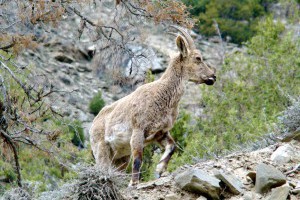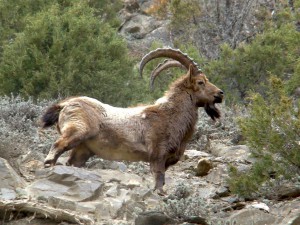
Capra sibirica (Himalayan Ibex)
| Common name | Himalayan Ibex |
| Latin name | Capra sibirica |
| Local name | Tangrol |
| IUCN/WPA/Indian status | Least Concern/I/Uncommon |
| Social unit | Large feeding aggregations of up to 100 animals can be seen in spring, average herd size |
| Size / weight | 10-15 Size HBL 103-132 cm (male), 85-101 cm(female),HAS 65-105 cm, HL 90-148 cm (male), 19-39 cm (female) Weight 60-130 Kg ( male ), 30-56 kg (female) |
| Description | The Himalayan Ibex male is easily told apart from other caprids by his characteristic horn and beard. Female are grey brown in colour with less distinct white underpants, have thin parallel horns and dark markings on their legs. Both sexes have a dark dorsal stripe down the length of their back and short dark furry tails |
| Behavior | The Ibex does not always migrate to lower heights in winter and mostly stays at fairly high altitude using wind blown ridges. Unlike other caprids, the Ibex is known to dig crates through snow to access forage in winter |
| Distribution | Trans Himalayas region of Ladakh and the Greater Himalayas and Pir Panjals of Jammu & Kashmir and Himachal Pradesh. The eastern limit seems to be the Bara Lacha La Pass on the north and Satluj Gorge south of the Great Himalayan Range in Himachal Pradesh. The Southern most populations may occur south of the Pir Panjal Range in Manali WLS in Himachal Pradesh. |
| Habitat | Steep crags above the tree line in the Himalayas up to 5500 m. In Himalayas frequents 3400-4400 m. while in trans Himalayas frequents 4000-4725 m. Grazes on alpine pastures and wet meadows but always close to rocky precipitous terrain. Occasionally enters forests. |
| Best seen | Pin Valley NP, Himachal Pradesh, Kanji WLS, Jammu and Kashmir |




